Automotive HUD Market by Technology (2D HUD, AR HUD, 3D HUD), HUD Type (Combiner, Windshield), Offering (Hardware, Software), Vehicle Class, Level of Autonomy, Vehicle Type, Propulsion Type, EV Type and Region - Global Forecast to 2030
[260 Pages Report] The global automotive HUD market size is projected to grow from USD 1.2 billion in 2024 to USD 2.4 billion by 2030, at a CAGR of 12.3%. With the increase in awareness of the safety of vehicles and passengers Demand for better In-vehicle experience, growing preference towards connected vehicles steady increase in the market for premium and luxury vehicles, primarily in emerging markets are expected to increase the demand for automotive HUD solutions all over the world. Moreover, increasing adoption of electric vehicles along with growing demand for semi-autonomous vehicles are also expected to create lucrative opportunities for the automotive HUD market in the coming years globally.
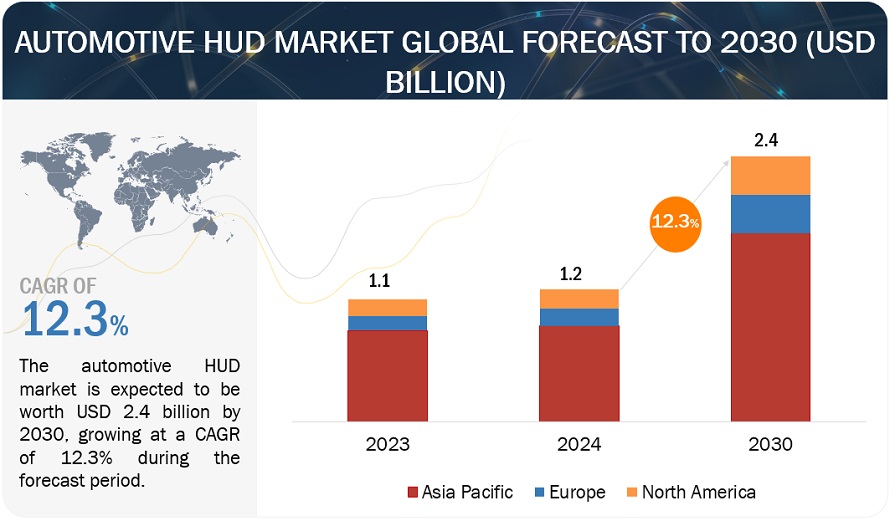
To know about the assumptions considered for the study, Request for Free Sample Report
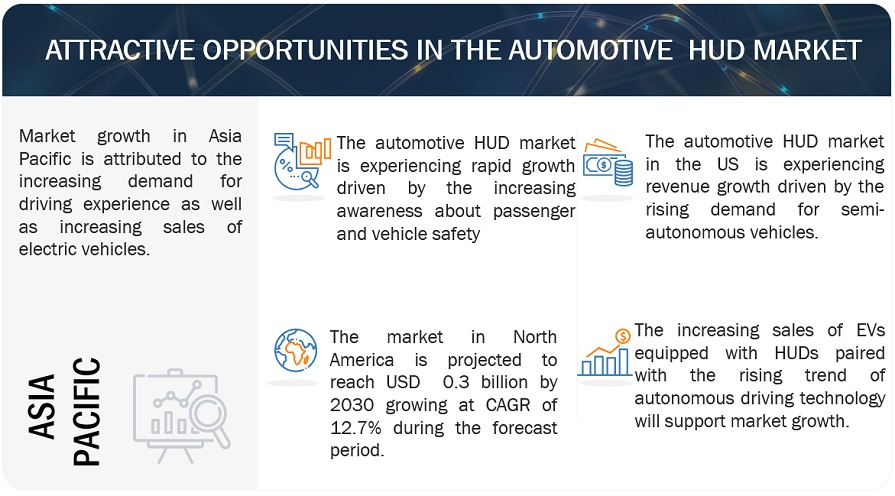
To know about the assumptions considered for the study, download the pdf brochure
Automotive HUD Market Dynamics:
Driver: Steady growth in demand for luxury and high-end segment cars, mainly in emerging markets
The revenue growth of the automotive HUD market is expected to be supported by the consistent growth in demand for luxury vehicles during the forecast period. Automotive HUD technology was first introduced by luxury cars. Luxury car manufacturers have integrated HUDs into their top-of-the-line models after realizing how valuable they are for enhancing the driving experience. For example, automotive HUDs are available for the Audi Q4 e-tron, BMW iX, BMW iX3 (RR), and Mercedes-Benz EQE. Furthermore, cutting-edge features and technologies are frequently introduced into luxury cars. As a result, technological developments in car HUDs for luxury vehicles have continued. Wider viewing angles, enhanced display clarity, augmented reality capabilities, and interaction with other cutting-edge systems like adaptive cruise control and night vision are some of these innovations. All these aforementioned parameters are expected to support the growth of the automotive HUD market.
Restraint: Requirement for greater space in automotive cockpits
The automotive industry is undergoing a significant shift toward creating more spacious vehicle cockpits, driven by several factors. This shift includes integrating advanced technologies such as larger displays, augmented reality (AR) HUDs, and sophisticated driver assistance systems (ADAS), all of which require additional space to prevent cockpit overcrowding. Concurrently, manufacturers are focusing on improving overall comfort and convenience, leading to enhancements in seating arrangements and legroom. There is a noticeable trend driven by consumer preferences for personalized interiors, resulting in more spacious cockpits that can be customized according to individual tastes. The windshield-projected HUD demands substantial space in the cockpit. Advanced HUDs, such as AR HUDs, enhance driving comfort and safety by overlaying the exterior view of traffic conditions with virtual information for the driver. This reflected information appears to be part of the driving situation itself. Additionally, companies are developing next-generation HUD technology and researching related areas like Holographic Optical Elements (HOE) and optical waveguides, which require significant dashboard space and necessitate cockpit redesigns by OEMs. For example, the initial AR HUD model developed by Continental AG (Germany) requires 10 liters of cockpit space, presenting a challenge for OEMs to incorporate.
Opportunity: Increasing demand for semi-autonomous vehicles
The increased level of autonomy in cars presents a significant opportunity for developing and adopting automotive heads-up displays (HUDs). With higher levels of autonomy, HUDs can enhance safety and awareness by providing real-time contextual information, such as speed, navigation directions, and proximity warnings, directly in the driver’s line of sight. Advanced HUDs with augmented reality (AR) capabilities can highlight potential hazards and optimal driving paths, thereby improving situational awareness. HUDs also provide real-time feedback and alerts, enhancing the driver’s ability to respond to dynamic driving conditions. Thus, the upcoming shift of reducing non-autonomous vehicle market share to semi-autonomous vehicles will create new opportunities for the automotive HUD market. Such parameters are expected to augment revenue for the automotive HUD market during the forecast period.
Challenge: Optical Challenges in head-up disp lay systems
Automotive HUD systems encounter several difficulties, including glare, distortion, visibility in bad weather, readability in sunshine, and integration with augmented reality. Glare reflects information off the windshield, which can reduce visibility. Glare is especially common in strong sunshine. Reducing glare requires careful optic design and may involve anti-glare coatings. Image clarity is compromised by distortion, which results from optical aberrations or misalignment within the HUD system. Advanced optical design and calibration procedures are essential to reduce distortion. Unfavorable meteorological conditions like rain, fog, or snow make visibility problems worse by distorting light or producing a diffused background that makes it difficult to read. To overcome these obstacles, developing HUD systems with improved contrast and brightness capabilities is necessary. Sunlight readability is crucial for driver safety and convenience, making high-brightness display technology and HUD optic optimization crucial.
Automotive HUD Market Ecosystem
The ecosystem analysis highlights various players in the automotive HUD ecosystem, which OEMs, HUD providers, HUD suppliers, and software providers primarily represent. Prominent companies in this market include Continental AG (Germany), Foryou Corporation (China), DENSO Corporation (Japan), Yazaki Corporation (Japan), Panasonic Holdings Corporation (Japan), and Nippon Seiki Co., Ltd. (Japan), among others.
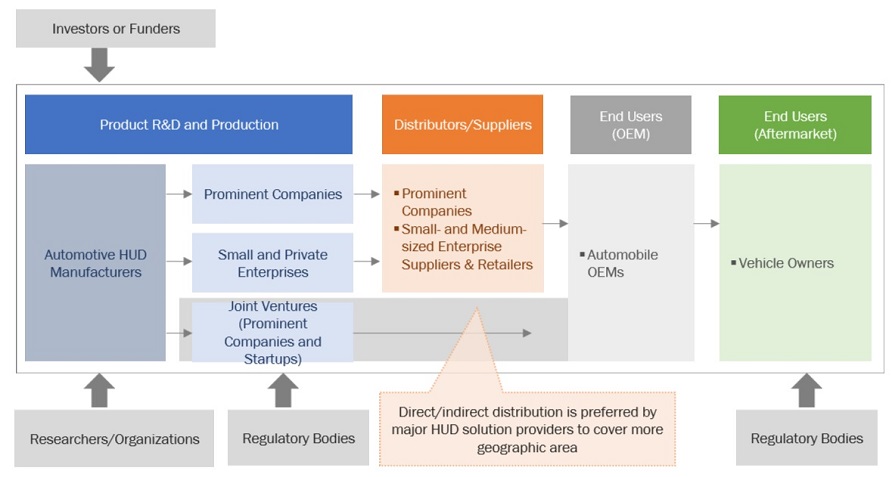
Passenger car segment is projected to witness significant growth rate in the global automotive HUD market during the forecast period.
The passenger cars segment is expected to dominate the automotive HUD market during the forecast period. This is due to the widespread adoption of cutting-edge technologies continues to be high for passenger cars due to the higher production and sales of passenger cars worldwide compared to commercial vehicles. For example, the most recent Passenger HUDS (P-HUDs) have transformed vehicle HUD technologies by seamlessly integrating external traffic views with augmented visuals. One of its primary objectives is to improve driving and facilitate objective passenger interactions. OEMs face the need to include these elements in their cars as a result of consumers' growing demand for luxury and convenience amenities.
Leading manufacturers such as Audi AG (Germany), Geely (China), BMW AG (Germany), Great Wall Motor (China), NIO (China), and Hongqi (China) have increasingly integrated HUDs into their vehicles. Companies such as Nippon Seiki Co., Ltd (Japan), Continental AG (Germany), Foryou Corporation (China) Yazaki Corporation (Japan), Panasonic Holdings Corporation (Japan), and WayRay AG (Switzerland), among others, offer automotive HUDs for passenger cars.
By propulsion type, ICE vehicles segment is expected to be the largest in automotive HUD market during the forecast period.
Modern ICE vehicles are equipped with many connected features in addition to ADAS technology. Automotive HUDs can be easily integrated with advanced driver assistance systems (ADAS) used in internal combustion engine (ICE) automobiles. Critical information like as lane departure alerts, adaptive cruise control information, and collision warnings are then sent to the driver or owner of the car. Buyers of internal combustion engine (ICE) vehicles may find HUDs appealing due to their ability to improve overall safety when combined with driver assistance technologies. These elements are expected to support the automotive HUD market's ICE cars segment during the forecast period. Because of the increased demand for passenger cars, the Asia Pacific region is anticipated to hold the highest share in this market.
AR HUD segment is expected to have significant growth opportunities in automotive HUD market during the forecast period.
AR HUD segment is expected to be driven by technological improvements and growing consumer desire for better safety features. Road accidents can occur when a driver is distracted by various in-car displays. Vehicle distraction can be decreased, and driving safety can be increased using AR HUD systems. AR HUDs, for example, can be used to enhance driving experience by highlighting impediments on the displayed image and pointing to nearby roadways during guidance routing. Advancements in AR-based HUD technology are expected to create significant revenue opportunities for HUD manufacturers. These AR HUDs are more interactive and capable of projecting complex graphics that align with real-world objects. By overlaying AR graphics onto real-world scenes, drivers can quickly identify and respond to threats, such as braking for obstacles on the road. These innovations are expected to drive demand for AR HUDs in the premium vehicle segment during the forecast period.
“The Asia Pacific automotive HUD market is projected to hold the largest share by 2030.”
Asia Pacific is estimated to be the largest market for automotive HUDs by 2030. In this region, leading countries such as China, Japan, India, and South Korea are expected to develop autonomous driving technology in the coming years. Leading OEMs in this region, such as Toyota, Honda, and Hyundai, have utilized the advantages of in-vehicle experiences and safety systems features as a standard across their models. China is expected to be the most significant factor in the Asia Pacific automotive HUD market growth in terms of value & volume. China leads the region in terms of value and volume for automotive HUD market, which can also be attributed to the increased demand for EVs and increased sales of vehicles equipped with HUD technology. For example, BYD Song L, Changan Raeton PLUS, Changan CS75, and Haval H6 are some of the models in China equipped with automotive HUDs.
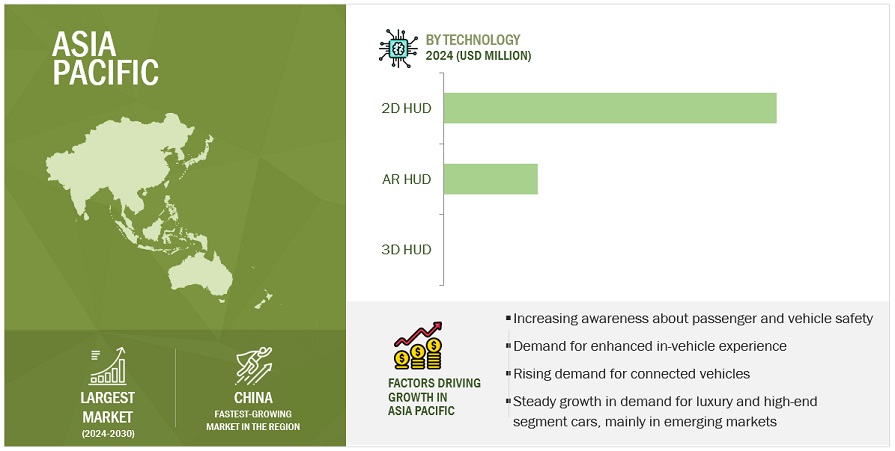
Key Market Players
The global automotive HUD market is dominated by major players such as Nippon Seiki Co. Ltd. (Japan), Continental AG (Germany), DENSO Corporation (Japan), Panasonic Holdings Corporation (Japan), Foryou Corporation (China), Yazaki Corporation (Japan), and Valeo (France), and among others. These companies have strengthened distribution networks at a global level and offer a wide range of HUD products such as combiner HUDs, and windshield HUDs. The key strategies adopted by these companies to sustain their market position are collaborations, new product developments, acquisitions, etc.
Get online access to the report on the World's First Market Intelligence Cloud
- Easy to Download Historical Data & Forecast Numbers
- Company Analysis Dashboard for high growth potential opportunities
- Research Analyst Access for customization & queries
- Competitor Analysis with Interactive dashboard
- Latest News, Updates & Trend analysis
Request Sample Scope of the Report
Get online access to the report on the World's First Market Intelligence Cloud
- Easy to Download Historical Data & Forecast Numbers
- Company Analysis Dashboard for high growth potential opportunities
- Research Analyst Access for customization & queries
- Competitor Analysis with Interactive dashboard
- Latest News, Updates & Trend analysis
|
Report Metric |
Details |
|
Market size available for years |
2020–2030 |
|
Base year considered |
2023 |
|
Forecast period |
2024-2030 |
|
Forecast units |
Volume (Thousand Units) & Value (USD Million) |
|
Segments Covered |
HUD Type, Technology, Level of Autonomy, Offering, Vehicle Type, Propulsion Type, EV Type, Vehicle Class, and Region |
|
Geographies covered |
Asia Pacific, North America, and Europe. |
|
Companies Covered |
Nippon Seiki Co. Ltd. (Japan), Continental AG (Germany), DENSO Corporation (Japan), Panasonic Holdings Corporation (Japan), Foryou Corporation (China), Yazaki Corporation (Japan), and Valeo (France). |
This research report categorizes the automotive HUD market based on HUD type, technology, vehicle class, vehicle type, EV type, propulsion type, level of autonomy, offering, and region.
Automotive HUD Market, By Technology
- AR HUD
- 3D HUD
- 2D HUD
Automotive HUD Market, By HUD Type
- Combiner HUD
- Windshield HUD
Automotive HUD Market, By Vehicle Class
- Economy Car
- Mid-segment Car
- Luxury Car
Automotive HUD Market, By Vehicle Type
- Passenger Car
- Commercial Vehicle
Automotive HUD Market, By Electric Vehicle Type
- BEVs
- PHEVs
- HEVs
- FCEVs
Automotive HUD Market, By Propulsion Type
- ICE Vehicles
- Electric Vehicles
Automotive HUD Market, By Level of Autonomy
- Non-autonomous car
- Semi-autonomous car
- Autonomous car
Automotive HUD Market, By Offering
- Software
- Hardware
Automotive HUD Market, By Region
-
North America
- US
- Canada
- Mexico
-
Europe
- France
- Germany
- UK
- Spain
- Italy
-
Asia Pacific
- China
- Japan
- India
- South Korea
Recent Developments
- In March 2024, Panasonic Holdings Corporation and Mazda Motor Corporation partnered and installed full-display meters for the CX-70 model of Mazda Motor Corporation. The CX-70 integrates a large 12.3-inch display, showcasing graphics of the vehicle conditions, such as speed and warnings. It adapts in real-time to offer drivers timely and pertinent information, enhancing their safety and driving experience.
- In February 2024, Nippon Seiki Co., Ltd. and FPT Software partnered to develop automotive HUD platforms and applications for automobiles and motorcycles.
- In July 2023, Panasonic Automotive Systems Co., Ltd., Holding of Panasonic Holdings Corporation, announced that its intelligent room mirror (electronic mirror), linked with a drive recorder and HUD, has been adopted for the new Nissan Serena e-Power. The HUD linked with the mirror uses a 2-megapixel camera, a high-resolution display, and proprietary image processing technology to achieve high-definition images and improved nighttime visibility.
- In June 2023, Continental AG introduced its Smart Cockpit High-performance Computer (HPC), which offers ideally adapted system performance for a pre-integrated set of functions in vehicles. This Smart Cockpit HPC integrates various domains and functions, such as cluster, infotainment with an interface to an Android Operating System, and Advanced Driver-Assistance Systems (ADAS), in one box. This system is designed for the typical configuration of two displays for the center stack and the instrument cluster and can be expanded to include up to three displays, such as a head-up display.
- In January 2023, N.S. Computer Service Co., Ltd., a subsidiary of Nippon Seiki Co., Ltd with Akita City, Akita Prefecture, to open Akita Development Center, a new software development center to strengthen its software development system for advanced driver assistance systems (ADAS) and other applications. This center develops software for automotive electric control units (ECUs) used in meters, HUDs, and drive system parts.
Frequently Asked Questions (FAQ):
What is the current size of the global automotive HUD market?
The global automotive HUD market is estimated to be USD 1.2 billion in 2024 and is projected to reach USD 2.4 billion by 2030.
Who are the winners in the global automotive HUD market?
The automotive HUD market is dominated by global players such as Nippon Seiki Co. Ltd. (Japan), Continental AG (Germany), DENSO Corporation (Japan), Panasonic Holdings Corporation (Japan), and Foryou Corporation (China), among others. These companies develop new products, adopt expansion strategies, and undertake collaborations, partnerships, and mergers & acquisitions to gain traction in the automotive HUD market.
What are the new market trends impacting the growth of the automotive HUD market?
Increasing demand for AR HUDs, and growing sales of luxury vehicles equipped with automotive HUDs are some of the major trends affecting this market.
Which region is expected to be the largest market during the forecast period?
Asia Pacific is expected to be the largest market in the automotive HUD market vehicles due to the increase in demand of EVs and increased sales of vehicles equipped with HUD technology especially in China.
What is the total CAGR expected to be recorded for the automotive HUD market during 2024-2030?
The CAGR is expected to record a CAGR of 12.3% from 2024-2030. .
To speak to our analyst for a discussion on the above findings, click Speak to Analyst
The study involved four major activities to estimate the current size of the automotive HUD market. Exhaustive secondary research was done to collect information on the market, the peer market, and model mapping. The next step was to validate these findings, assumptions, and sizing with the industry experts across value chains through primary research. The bottom-up and top-down approaches were employed to estimate the total market size. After that, market breakdown and data triangulation were used to determine the market size of segments and subsegments.
Secondary Research
Secondary sources referred to for this research study included automotive industry organizations involved with head-up display; publications from government sources [such as country level automotive associations and organizations, Organisation for Economic Co-operation and Development (OECD), World Bank, CDC, and Eurostat]; corporate filings (annual reports, investor presentations, and financial statements); and trade, business, and automotive associations. Secondary data was collected and analyzed to arrive at the overall market size, which was further validated through primary research.
Primary Research
Extensive primary research was conducted after acquiring an understanding of the automotive HUD market scenario through secondary research. Several primary interviews were conducted with market experts from both the demand (OEMs) and supply (automotive HUD manufacturers, and Tier II suppliers) sides across major regions, namely, North America, Europe, and Asia Pacific. Approximately 40% and 60% of primary interviews were conducted from the supply side & industry associations and dealers/distributors, respectively. Primary data was collected through questionnaires, emails, and telephonic interviews. In the canvassing of primaries, various departments within organizations, such as sales, operations, and administration, were considered to provide a holistic viewpoint in this report.
After interacting with industry experts, brief sessions with highly experienced independent consultants were conducted to reinforce the findings from primaries. This, along with the in-house subject matter experts’ opinions, led to the findings as described in the remainder of this report.
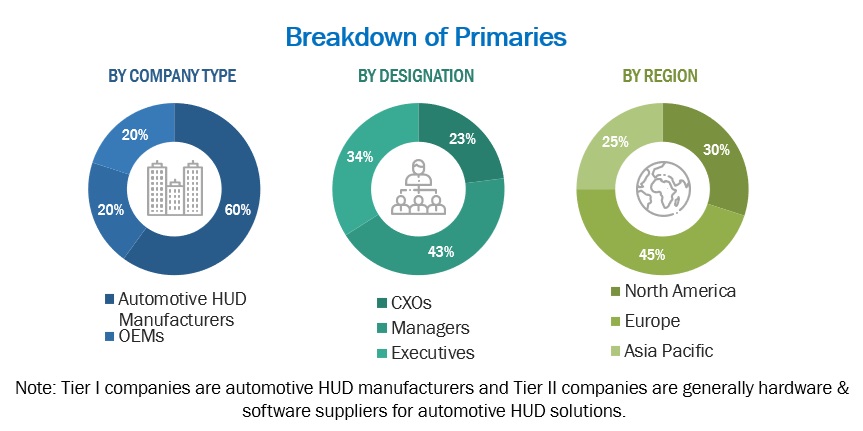
To know about the assumptions considered for the study, download the pdf brochure
Market Size Estimation
The bottom-up approach was used to estimate and validate the size of the automotive HUD market. In the bottom-up approach, the number of vehicle production of each vehicle type at the country level was considered. The number was then multiplied by the country-level penetration of HUDs for each vehicle type to determine the market size of automotive HUDs, in terms of volume. The country-level passenger car market was then multiplied with the penetration of vehicle class (economy cars, mid-segment cars, and luxury cars) to determine the market size of automotive HUDs by vehicle class. The country-level market of each vehicle class was then multiplied by the penetration of HUD type to determine the automotive HUD market, by type, in terms of volume. The country-level market size, in terms of volume, of automotive HUDs, by type, was then multiplied by the country-level Average OE Price (AOP) of each HUD type to determine the market of each vehicle class in terms of value. A summation of country-level value for each vehicle class was carried out to determine the country-level market of passenger cars. Further, the AOP of HUD was multiplied by the volume of light commercial vehicle and heavy commercial vehicle automotive HUD markets. Summation of the country-level market for each vehicle, by value, enabled the estimation of the country-level market size, in terms of value. The summation of the country-level market led to the regional market size, and further summation of the regional markets provided the global automotive HUD market size.
- The key players in the industry and markets have been identified through extensive secondary research.
- The industry’s future supply chain and market size, in terms of value, have been determined through primary and secondary research processes.
- All percentage shares, splits, and breakdowns have been determined using secondary sources and verified through primary sources.
Global Automotive HUD Market Size: Bottom-Up Approach
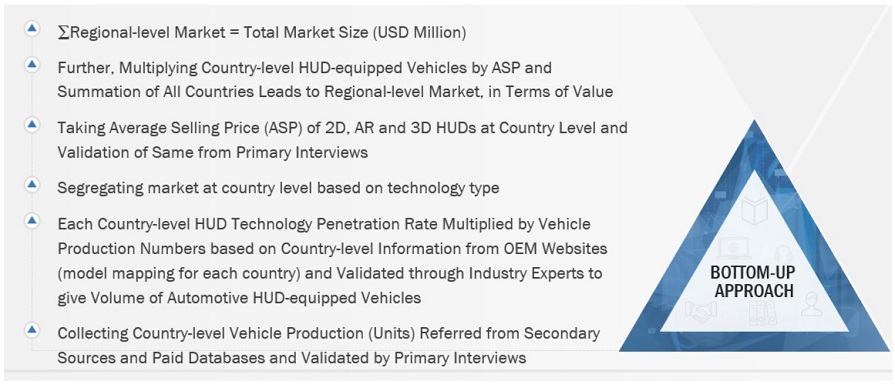
To know about the assumptions considered for the study, Request for Free Sample Report
The top-down approach was used to estimate and validate the market size of the automotive HUD by offering (value) and level of autonomy (volume and value). In this approach, offering, and level of autonomy of automotive HUDs were identified at the regional level. The market share of each offering, and level of autonomy was identified for each region. The market shares were then multiplied by the volume and value of the global automotive HUD market, respectively. All regional data were added to derive the global automotive HUD market for respective segments.
Global Automotive HUD Market Size: Top-Down Approach

Data Triangulation
After arriving at the overall market size of the global market through the above-mentioned methodology, this market was split into several segments and subsegments. The data triangulation and market breakdown procedure were employed, wherever applicable, to complete the overall market engineering process and arrive at the exact market value data for the key segments and subsegments. The extrapolated market data was triangulated by studying various macro indicators and regional trends from both the demand- and supply-side participants.
Market Definition
Automotive HUD: As per Continental AG (Germany), the Head-up Display (HUD) shows directly in the line of sight. Drivers get all the important information such as speed, warning signals and indicator arrows for navigation without looking down to the instrument cluster or the secondary display.
Key Stakeholders
- ADAS Integrators
- ADAS/Occupant Safety Solution Suppliers
- Augmented Reality HUD Technology Providers
- Automobile Organizations/Associations
- Automotive Augmented Reality HUD Manufacturers
- Automotive Display Suppliers
- Automotive Electronic Hardware Suppliers
- Automotive Electronic System Integrators
- Automotive HUD Manufacturers
- Automotive Smart Display Panel Manufacturers
- Automotive SoC and ECU Manufacturers
- Country-specific Automotive Associations
- European Automobile Manufacturers’ Association (ACEA)
- EV and EV Component Manufacturers
- Government & Research Organizations
- HUD Technology Providers
- National Highway Traffic Safety Administration (NHTSA)
- Raw Material Suppliers for Automotive HUD Manufacturers
- Regulatory Bodies
- Software Providers
- Traders, Distributors, and Suppliers of Automotive HUDs
- Vehicle Safety Regulatory Bodies
Report Objectives
- To analyze and forecast the automotive HUD market in terms of value (USD million) & volume (thousand units), from 2020 to 2030
- To segment and forecast the market by value & volume based on region (Asia Pacific, Europe, and North America)
- To segment and forecast the market, by value & volume, based on HUD type (windshield HUD and combiner HUD)
- To segment and forecast the market, by value & volume, based on technology (AR HUD, 3D HUD and 2D HUD)
- To segment and forecast the market, by value & volume, based on vehicle class (mid-segment cars, luxury cars, and economy cars)
- To segment and forecast the market, by value, based on offering (software, and hardware)
- To segment and forecast the market, by value & volume, based on vehicle type (passenger cars and commercial vehicles)
- To segment and forecast the market, by value & volume, based on level of autonomy (non-autonomous cars, semi-autonomous cars, and autonomous cars)
- To segment and forecast the market, by value & volume, based on propulsion type (ICE vehicles and electric vehicles)
- To segment and forecast the market, by value & volume, based on EV type (BEVs, FCEVs, HEVs, and PHEVs)
- To provide detailed information about the factors influencing the market growth (drivers, challenges, restraints, and opportunities)
- To strategically analyze the market with respect to individual growth trends, prospects, and contributions to the total market
-
To study the following with respect to the market
- Supply Chain Analysis
- Ecosystem
- Technology Analysis
- Case Study Analysis
- Patent Analysis
- Tariff and Regulatory Landscape
- Average Selling Price Analysis
- Buying Criteria
- To strategically profile the key players and comprehensively analyze their market share and core competencies
- To analyze the opportunities for stakeholders and the competitive landscape for market leaders
- To track and analyze competitive developments such as deals, product developments, expansions, and other activities undertaken by the key industry participants
Available Customizations
With the given market data, MarketsandMarkets offers customizations in accordance to the company’s specific needs.
- Automotive HUD market, by EV type, at a regional level
- Automotive HUD market, by vehicle autonomy, at a regional level
- Profiling of additional market players (Up to 5)




 Generating Response ...
Generating Response ...







Growth opportunities and latent adjacency in Automotive HUD Market
for this report (HUD) do you have volume forecast breakdown between OEM preinstalled and aftermarket?